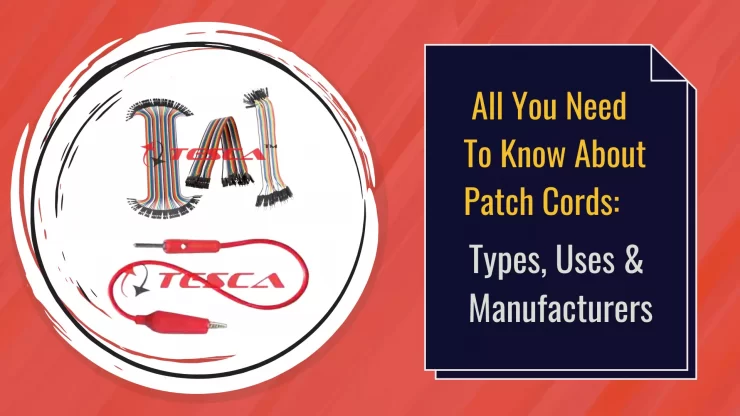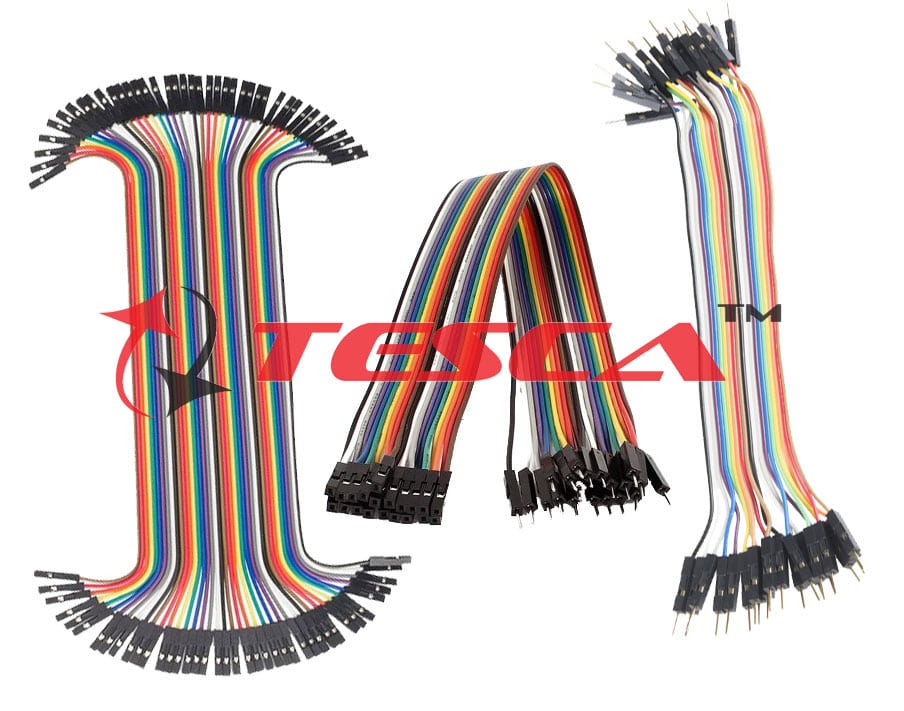Table of Contents
When we mention a piece of must-have electric equipment is of utmost importance in any given industry, it is undoubtedly the Patch Cords.
Patch Cord is an electronic cable that is quite useful in different sectors. So if you are not aware of these devices and we are here to provide you detailed info about patch cords here:
What is a Patch Cord?
A patch cord is a piece of equipment used for connecting network devices with one another. In simple words, it is a small cable that connects two devices, and combines the devices through their various ports, allowing them to exchange data.
Patch cords have fiber optic cable material that uses light pulses to send and receive data.
They are also referred to as patch leads, jumper cables, jumpers, patch wires, or patch lines, depending upon the region where one uses these.
How Many Types of Patch Cords are there?
There are several types of patch cords; mainly there are two types of patch cords:
- UTP (Unshielded Twisted Pair) and
- STP (Shielded Twisted Pair).
UTP patch cords can be classified into three categories: Straight-through, Crossover, and Rollover.
STP patch cords can be classified into straight-through and Crossover.
Let us know more about the types of patch cords here:
1. OFC Patch Cord:
OFC Patch Cord is a multimode or single-mode fiber optic cable restrained at either end with connectors that allow it to be rapidly and conveniently conjoined to CATV, an optical switch, or other telecommunication equipment.
Its thick layer of security helps connect the optical transmitter, receiver, and terminal box.
2. LC-LC Patch Cord:
L.C. patch cord is an essential component for data center and network deployment, and it provides the necessary connectivity between fiber optic equipment.
L.C. cable assembly offers a simple solution for installing and maintaining fiber optic cables in high-density applications.
It is easy to change or rearrange your cabling with an L.C. patch cord without reconfiguring the entire system.
The ends of an L.C. fiber optic patch cord are identical in appearance, and the orientation of the cable can only differentiate it.
3. S.C. to L.C. Patch Cord:
A Standard-Cable (S.C.) to a Low-Profile-Cable (LPC) is a conversion from a larger type of connector to a smaller one that connects devices with a small form factor connector (S.C.) to devices with a larger form factor connector (L.C.).
It is useful in connecting any device with a single-mode fiber optic connector to a multimode connection.
The SC connector is typically beneficial on the transmitting end of the line during the L.C. connector on the receiving end.
As its name suggests, the L.C. connector has a smaller form factor than the S.C. connector and is typically helpful in high-density applications such as data centers and telecommunications.
4. Optical Fiber Patch Cord:
An optical fiber patch cord is a valuable cable connecting two optical fibers. It is typically made up of a connector on each end, and a flexible or rigid sleeve, which protects the connectors and helps the cable jacket stays in place.
It is a small, rugged optical link connector that provides high-bandwidth transmission over a short distance.
Optical fiber patch cords are one of the most critical components in an optical network. It helps connect an optical network terminal to a fiber splice closure or an optical distribution frame.
5. S.C. to F.C. Patch Cord:
An SC to F.C patch cord is a cable with a connector on one end and a connector on the other end. The connectors are specifically designed for fiber optic cables.
These cables provide connectivity between a transceiver and a fiber optic device. They consist of a thin plastic jacket over a single glass or plastic fiber core.
The connectors at each cable end usually have molded boots and thumbscrews for protection.
They can also connect two transceivers. These cables have compatibility with single-mode and multimode specifications by having an S.C. connector at one end and F.C. connectors (S.C., S.T., L.C.) at the other end.
6. Single-Mode Fiber Patch Cord:
A single-mode fiber patch cord refers to a fiber optic cable with two ends helpful for optical networking.
It has a high-speed transmission medium compared to multimode and low attenuation.
It is often beneficial in network hardware like switches, routers, and fiber optic cables. It is most commonly helpful in Ethernet network architecture, and it is also referred to as an Ethernet cable.
7. Multimode Patch Cord:
A multimode patch cord (also known as multimode or MM fiber) is a fiber optic cable that can connect a single device to another device or multiple devices.
It is a patch cord with two or more connectors at both ends. Two connectors are used to create a duplex connection, and more than two connectors are used to develop multiport relationships in the network.
Multimode fiber optic cabling applications commonly connect a computer network interface card or a multiplexer/demultiplexer to a fiber optic backbone or communications cable.
8. Patch Cord CAT6:
CAT6 Patch Cable is a high-quality network cable used to connect computer equipment. It usually has eight wires surrounded by an outer covering for protection and insulation.
The eight wires consist of 4 twisted pairs of 24 gauge wire, each color-coded. These are usually helpful in connecting an Ethernet switch or hub to a computer, server, or other networking equipment.
9. D-Link Patch Cord:
The D-Link Patch Cord is a twisted stranded cable terminated with modular plugs at both ends. These cables include two pairs of wires: one for transmitting data and the other for receiving data.
Each twisted pair is usually wrapped in foil. The foil shields the wires from outside interference, thus reducing noise. This patch cord is appropriate for high-speed data transmission.
10. SC-LC Patch Cord:
An SC patch cord is a short cable used to connect different networking devices.
SC-LC patch cord is a type of twisted-pair cable commonly valuable for 10/100/1000BaSE-T networks for connecting network interface devices to the hub or switch.
It has two connectors, which are usually more significant than the other. The smaller connector connects to one device while the larger connector connects to another device.
Read Also: What Is Operational Amplifier: Basics, Types, Uses, Advantages and Limitations
Uses of Patch Cords:
Patch cords have many uses in almost every industry. Some of the benefits are:
- Patch cords help connect network devices utilizing a serial connection, and they allow for an easy change in network arrangement and do not require the use of punch-down blocks or patch panels.
- The patch cords connect the computer system, monitors, printers, and data storage devices to a network.
- They are also valuable for connecting audio equipment such as speakers, microphones, and mixers.
- Patch cords are typically helpful when replacing the patch cord is more convenient or cheaper than repairing a broken connector on the equipment.
Price of Patch Cords:
Patch cords are cables that are quite affordable in comparison to other devices. The price range of patch cords depends upon the type of patch cord you want to purchase.
The average cost of a patch cord is around INR 100 to INR 5000, depending upon the type of patch cord and label.
Read also: What is Integrated Circuit: Types, Uses, & Applications of Integrated Circuit?
Tesca Global Patch Cords
Are you searching for a high-quality Patch cord supplier?
Well, Tesca Global, a rapidly growing international company, is here to provide you with high-quality patch cords for data and telephony applications.
Tesca Global is a patch cord manufacturer which bridges the gap between technology and business opportunities.
We have been developing fiber optic solutions for data transfer solutions.
Our cords are high-grade cable materials and feature a solid construction with precision molded connectors.
Tesca Global supplies different patch cords such as Pair Patch Cord Stackable, Jumper Wire female, etc. We offer a wide range of products in different shapes and sizes at a reasonable price. Some of the products are:
1. Tesca Global’s 10 Connecting Jumper Wire Male to Female – 12cm
2. Tesca Global’s 10 Connecting Jumper Wire Female to Female – 12cm
3. 2mm Pair Patch Cord Stackable Spring Loaded Plug – Brass Nickel Plated – 23 Strands of 38 SWG O.D. 3.0 mm
4. 10 Connecting Jumper Wire Female to Female – 24cm
All the patch cords from Tesca Global are of high quality.
Patch Cord, Fiber Optic Patch Cable, Fiber Optic Jumpers, Fiber Optic Jumper Cables are available in different types and sizes.
So you can buy Patch cables as per your requirement from Tesca Global whenever you want.
FAQs:
Can You Use a Patch Cable as an Instrument Cable?
Patch cables are generally used to connect instruments and audio gear to a console or computer, so this cable can also carry an audio signal.
It all depends on the quality of the patch cable you use and the connectors that go with it.
What are Patch Cables Speaker Cables?
Speakers are connected to a power amplifier through cables, and similarly, computers are also connected to monitors through wires.
So, when it comes to powering the speakers, we use speaker cables, but when connecting the monitor with the computer system, we use patch cords (or monitor cables).
What is a CAT6a Patch Cable?
CAT6a is the standard for data cabling infrastructure and has been designed to be compatible with the emerging 10Gbps applications such as VoIP (Voice Over I.P.) and CCTV.
The cable standard is also fully backward compatible with older systems and equipment, so one can upgrade without replacing your kit.CAT6a patch cables are mostly useful in structured cabling.
Which Cable is Commonly Referred to as Patch Cable?
A patch cable or patch cord is a type of cable that connects two devices to exchange data. It is a flat cable with connectors on each end, and it is typically used for short-distance connections between two devices.
Patch cables are commonly referred to as “ribbon cables” because of their flat and thin construction.






Add comment